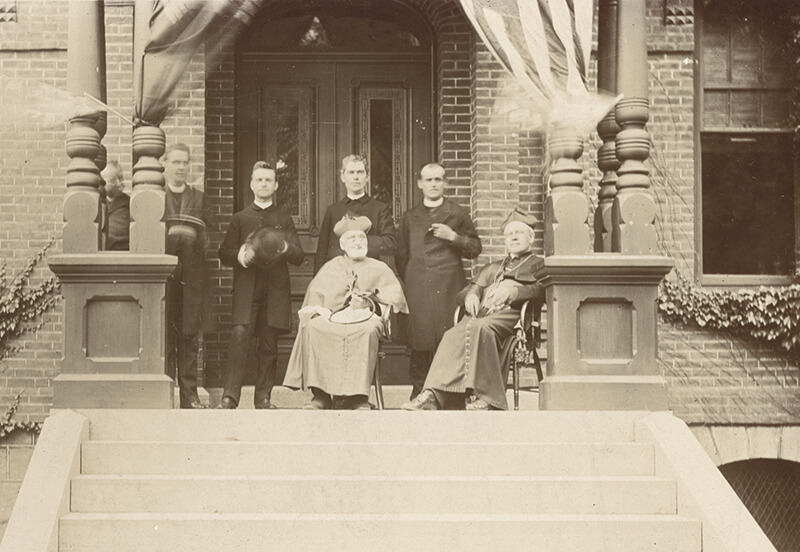
Cause for celebration: Bishop deGoesbriand to be recommended for sainthood
The first bishop of the Diocese of Burlington, Bishop Louis deGoesbriand, made God, the sacraments, education and assistance for the most vulnerable as accessible as possible to all entrusted in his care, explains Kathleen Messier, assistant archivist for the Diocese.
Indeed, many consider him to have been a saintly man, and soon, the process to declare him officially a saint is to begin.
Msgr. John McDermott, vicar general for the Diocese, said Burlington Bishop Christopher Coyne plans to announce the canonization cause at the conclusion of the last session of the current Diocesan Synod: “The first step, after the announcement of the process, is to develop and foster the cult/devotion of the faithful toward Bishop deGoesbriand.”
The process is directed through the Vatican’s Congregation for the Causes of Saints.
Born in France, Bishop deGoesbriand devoted his priestly life to missionary service in America.
When he arrived in Vermont in 1853, there were only eight churches throughout the state with five priests to minister to Catholics.
“Bishop deGoesbriand, even though he was raised in a well-respected and well-to-do household, lived in austere simplicity,” Messier said. “In several biographical accounts of Burlington’s founding bishop, his Christ-like love of the poor and children has often been noted.”
Though he had inherited from his parents about a quarter of a million dollars, by the time he died in 1899, he had spent his entire fortune; he had only $2.12 to his name and a few old suits, noted Father Lance Harlow, rector of St. Joseph Cathedral who wrote a biography of the bishop in 2001.
Bishop deGoesbriand spent his funds on the purchase of church property, building churches, establishing and supporting an orphanage and helping the poor residents of Burlington as well as his priests who were struggling in poor parishes.
“Researching his life forever changed the direction of my priesthood in that the saintly qualities of his life have become a model for me how to live: to devote myself whole-heartedly to my Diocese, to labor to promote the Catholic faith by writing and today by the internet; by teaching the history of great Catholics in the Diocese, to use my financial resources for the poor; and to have a deep trust in the Blessed Virgin Mary and in his motto that God will provide,’” Father Harlow said.
There are no known miracles attributed to Bishop deGoesbriand, but his contemporaries had described him as “the saintly bishop.”
In the 1930’s, there had been discussion about pursuing his cause for canonization, but in a missionary Diocese such as Vermont, “the needs of taking care of parishes precluded any serious investigation into his heroic life, so nobody ever pursued it,” Father Harlow said.
Bishop Coyne was impressed with the sacrificial nature of Bishop deGoesbriand’s life and wanted to pursue the cause for canonization.
Bishop deGoesbriand’s “life was lived in true service to the flock entrusted to his care,” Msgr. McDermott said.
Saints with a connection to Vermont include St. Andre Bessette and St. Marianne Cope who had/have family in Vermont; Brother Joseph Dutton, a Stowe native who cared for lepers on Molokai for whom the Diocese of Honolulu has opened the cause canonization; St. John Paul II who visited Vermont while a cardinal; and St. Isaac Jogues and other North American martyrs who are believed to have done missionary work here.
Steps to becoming a saint:
- A bishop launches an investigation of the candidate’s life. The Church will also investigate the candidate’s writings to see if they possess “purity of doctrine.” All of this information is submitted to the Congregation for the Causes of the Saints. If considered worthy, the candidate is deemed a “Servant of God.”
- A Church official must prove — via documents and testimonies — the candidate lived heroic virtues. The congregation investigates if the candidate was motivated by a profound charity toward his or her neighbor and practiced the virtues in an exemplary manner and with heroism. Once approved, the candidate is deemed “Venerable.”
- Confirmation of a “miracle” is required. In verifying the miracle, the Church looks at whether God really performed a miracle and whether the miracle was in response to the intercession of the “Venerable.” If so, the person can be beatified and called “Blessed.”
- After beatification, another miracle is required for canonization and the formal declaration of sainthood.
—Originally published in the Spring 2019 issue of Vermont Catholic magazine.

